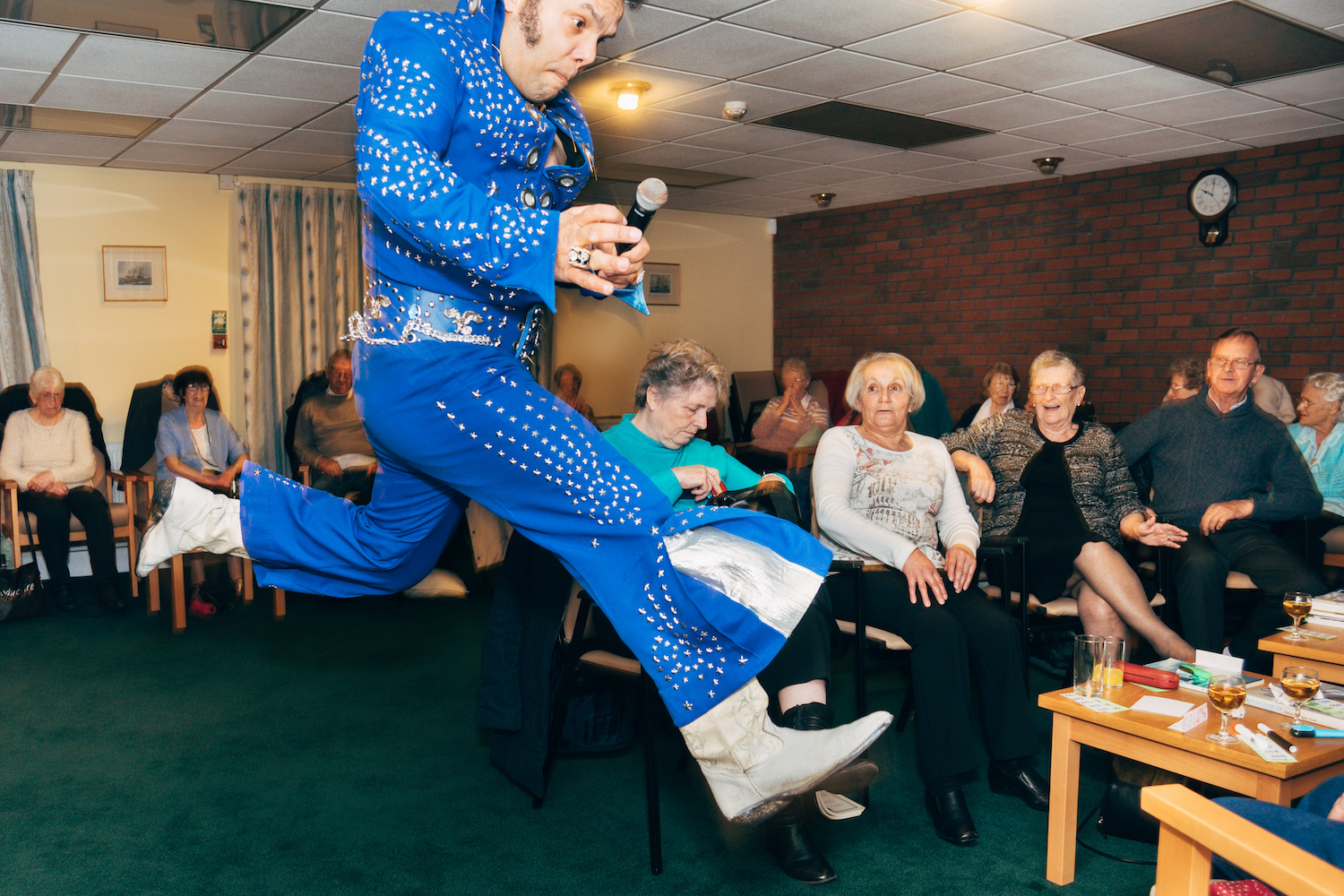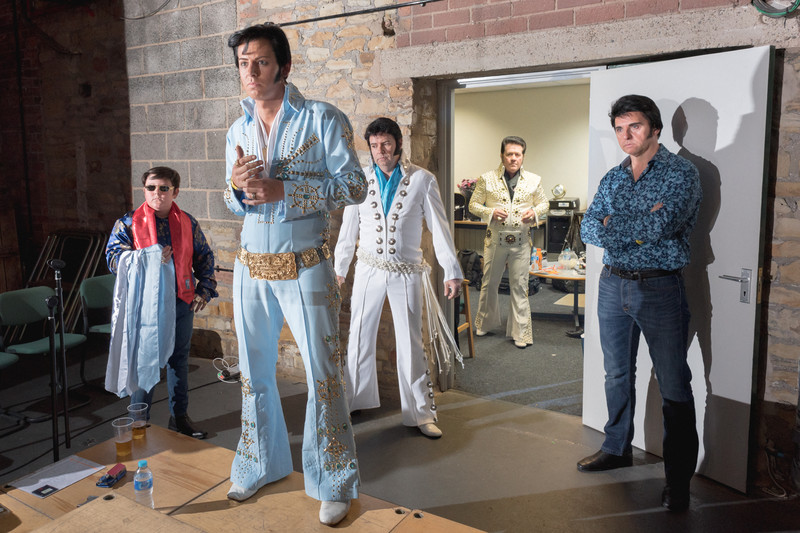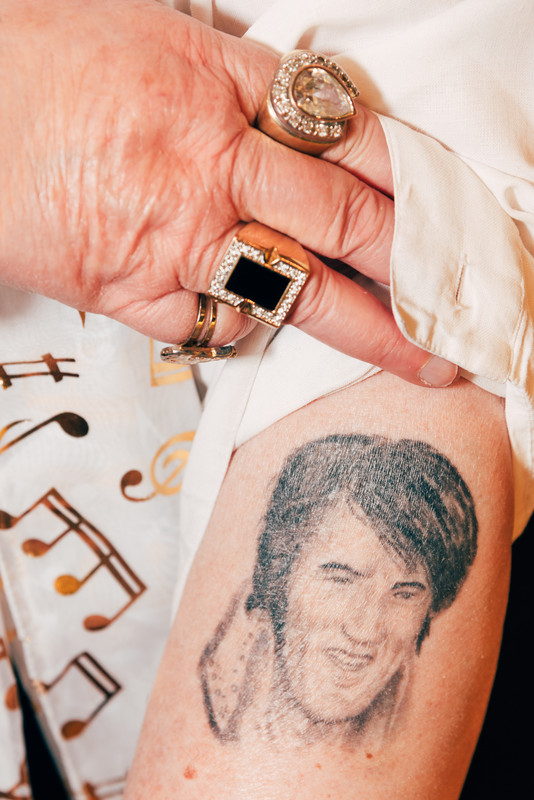The Kings Of England
© Graeme OxbyElvis is still an important cultural touchstone in working class communities all over the UK. It’s something to do with the story of a poor truck driver who rose to unimaginable fame and fortune. It’s about the songs, nostalgia and community. It’s also about love and faith as well as dressing up and having a good time.
A chance encounter with someone I knew ten years previously sparked off my interest in this important subculture. I met Parkin in a gas station. He was pumping unleaded into a giant Cadillac wearing a gold lame jacket and sunglasses. “I’ve changed my name to Elvis and I’m living the dream,” he said. I was hooked.
I began by documenting the sheer spectacle of what I saw– the exuberance, colour and drama of the Elvis Impersonators who I met at conventions, competitions, pubs and clubs and even in old folk’s homes.
As the project matured, I began to appreciate and photograph the individuals and their stories that lay behind the pageant. Revealed were individual stories of devotion, tragedy and resilience from the people who are at the heart of what this story is about.
A 2011 survey estimated that there were more than 85,000 Elvis Presley impersonators around the world. Elvis impersonation is a phenomenon spanning ages, cultures and countries. The man known as “The King of Rock and Roll” and often simply, “The King”, is proving immortal.



This both predates and goes beyond the karaoke mimicry of the post-Stars In Their Eyes performer. Elvis impersonation may be seen as that, of course, but these performances may also be acts of reification, of bringing the dead King back to life. There’s a kinship with medieval carnivals, where the lowest in society might be raised up to be bishop or a lord at times of feasting. There’s escapism and fun, and a purity and devotion that might make the cult of Elvis inaccessible or puzzling to those who are not true believers. There’s the mid-50s rockabilly Elvis of the Sun Studios era, the clean-cut GI, the 1960s bubble-gum movie star, the leather-clad revivalist rocker of 1968, the cat-suited and increasingly bloated and garish Vegas performer. There is blues and gospel, rock and roll and R‘n’B, pop and country and show tunes.
Several times throughout the year, the ETAs compete to present the most accurate rendition of Elvis Presley as a live performer, their research drawn second hand, for the most part, from personal collections of extensive audio-visual recordings. The winners of some of these events go on to compete in Memphis to try to win the title “Ultimate Elvis” and a cheque for $20,000
A few of the fans in the audience of these competitions, like “Polk Salad Annie” from Doncaster, actually saw Elvis in the flesh, and as a result are guests of honour whose opinion on the performers is eagerly sought after. Annie has said that seeing Elvis for the first time: “Was like looking at Jesus Christ”. Any link to the real, the “actual” Elvis, is revered and honoured, in much the same way as relics are in The Catholic Church. Perhaps due of the advanced age of the people involved, there is much disability evident in the audiences at the Elvis shows, which recalls a vision of pilgrims gathering be cured at and here are just about as many souvenirs as you will find in any gift shop in Lourdes.


The performers may make themselves in Elvis’s image, and may take from Elvis to make him in theirs. Despite being such a recognisable and singular figure, the “original” Elvis was in fact also a simulacrum, his act being based on African - American performers including Roy Hamilton, Chuck Berry, Little Richard, Willie Mae “Big Mama” Thornton and Arthur “Big Boy” Crudup as much as it was of his contemporaries Johnny Cash, Carl Perkins and Jerry Lee Lewis, a reality that Presley himself acknowledged.
It wasn’t originality that made him famous, it was the way that he was presented to the public which was different: Presley, together with his illegal immigrant manager “Colonel” Tom Parker, effectively invented pop stardom as we now understand it and in a career spanning thirty years, went from being a nobody to a level of celebrity never witnessed before. In America, more people watched his concert “Aloha from Hawaii” on TV than watched the moon landings. The global audience was estimated to be 1.5 billion.
What is perhaps immediately apparent about these photographs are the visual disconnects between Elvis Presley and his acolytes who appear imperfect, in varying degrees, when compared to the original. Yet it’s the imperfections that brought Presley down that make his story so poignant. Through the impersonators, these flaws are magnified, and this respect disclose Elvis as a tragic figure, a singular talent whose rise and fall exemplifies the destructive influence of the American Dream.



Forty years after his death in 1977, Elvis’s life and music is still celebrated widely in the UK. He remains one of the most recognisable pop culture figures. A 2015 exhibition of his personal effects was one of the biggest shows at the 02 in London and in 2016, The King topped the UK album charts with “The Wonder Of You”. Young people like Elias Boswell, a 14 year old Roma Gypsy Elvis are as fascinated with Presley as much as the largely ageing audience. The ETAs in this book range from professionals like Ben Thompson, who came second in the world championships in Memphis in July 2014, to Bobby Diamond, the self-styled “Black Elvis” from Hull who is a Tesco security guard by day and Elvis by night and occasional weekend. A German Elvis, Guido "Elvoice" Regenhard is such a fixture on the UK Elvis scene that he has his own UK fan club.
A German on the throne of England, who would have thought it?
Text – Eamonn Griffin
click to view the complete set of images in the archive
